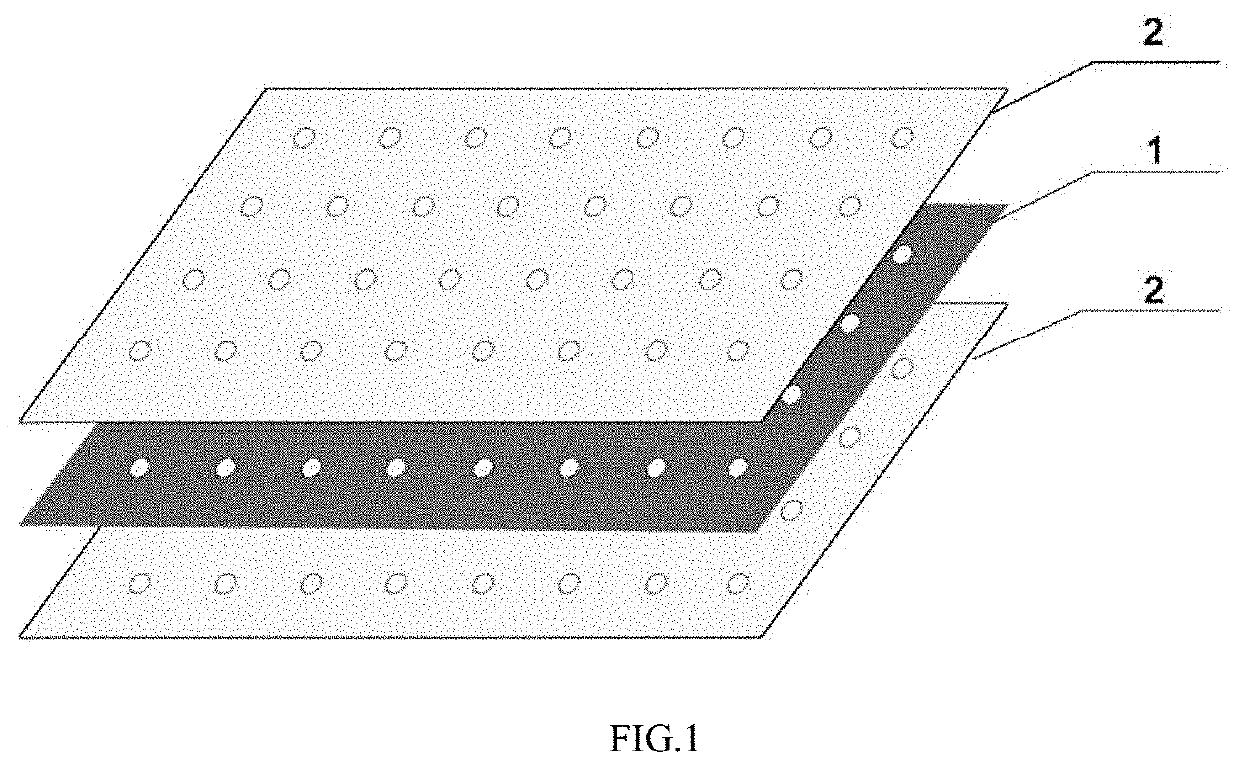Biological material with composite extracellular matrix components
a biomaterial and extracellular matrix technology, applied in the field of tissue repair materials, can solve the problems of long-term instability and loss of elasticity in implanted regions, difficult control, low bioactivity, etc., and achieve the effects of no excessive scarring, no excessive scarring, and slight tissue adhesion
- Summary
- Abstract
- Description
- Claims
- Application Information
AI Technical Summary
Benefits of technology
Problems solved by technology
Method used
Image
Examples
example 1
[0053]Porcine decellularized urinary bladder matrix (UBM) and decellularized small intestinal submucosa (SIS) were prepared. Spread a monolayered UBM out smoothly (the smooth surface being downward), composite SIS into an independent layer, each SIS being overlapped by 50%. Then place 4 aforesaid independent layers on the aforesaid UBM, each layer being interlaced by 90°. Place a monolayered UBM on the surface of the aforesaid layers (the smooth surface being upward). Dissipate bubbles, bind all interlayers with medical chitosan as adhesive, then press the above layers under −250 mm Hg for 24 h to make it become a whole material. The aforesaid material is perforated through all layers, the hole spacing being 5 mm, and the diameter of hole being 1 mm.
example 2
[0054]Porcine decellularized urinary bladder matrix (UBM) and decellularized small intestinal submucosa (SIS) were prepared. Spread 2 layers of UBM out smoothly (the smooth surface being downward), composite SIS into an independent layer, each SIS being overlapped by 50%, then place 6 aforesaid independent layers on the surface of UBM, each layers being interlaced by 90°. Spread 2 layers of UBM on the surface of the aforesaid layers (the smooth surface being upward). Dissipate bubbles, bind all interlayers with medical collagen as adhesive, then press the above layers under −300 mm Hg for 36 h to make it become a whole material. The aforesaid material is perforated through all layers, the hole spacing being 8 mm, and the diameter of hole being 2 mm.
example 3
[0055]According to GB / T528-2009, 3 samples were taken, each being 4 cm×1 cm in size and dumbbell-like in shape; aforesaid 3 samples were hydrated and then their two ends were fixed to a mechanical tester and pulled at the speed of 10 mm / min, and the tensile strength of those samples was 34±3 N / cm.
[0056]Three samples were taken and cut into 2 cm×5 cm in size; two ends of those samples were fixed to upper and lower clips of a tensile machine respectively, and those samples were peeled continuously at the speed of 10 mm / min till the overlapped part of them laminated; the force at stratification was recorded. The peeling strength of SIS-SIS and UBM-SIS was 6±2 N / cm, and the force for maintaining peeling was 1.5±0.5 N / cm.
[0057]The cytotoxicity of the said material was evaluated by the method claimed in GB / T 16886.5. NIH3T3 cells and L929 cells were used, and cell culture medium was used as extracting agent, extracts of gradient concentrations were used as cell culture media, and MTT meth...
PUM
| Property | Measurement | Unit |
|---|---|---|
| healing time | aaaaa | aaaaa |
| diameter | aaaaa | aaaaa |
| diameter | aaaaa | aaaaa |
Abstract
Description
Claims
Application Information
 Login to View More
Login to View More - R&D
- Intellectual Property
- Life Sciences
- Materials
- Tech Scout
- Unparalleled Data Quality
- Higher Quality Content
- 60% Fewer Hallucinations
Browse by: Latest US Patents, China's latest patents, Technical Efficacy Thesaurus, Application Domain, Technology Topic, Popular Technical Reports.
© 2025 PatSnap. All rights reserved.Legal|Privacy policy|Modern Slavery Act Transparency Statement|Sitemap|About US| Contact US: help@patsnap.com

